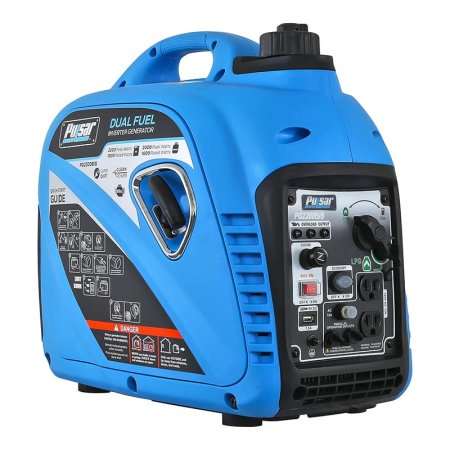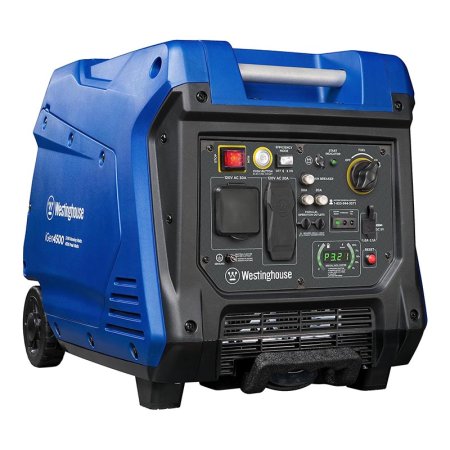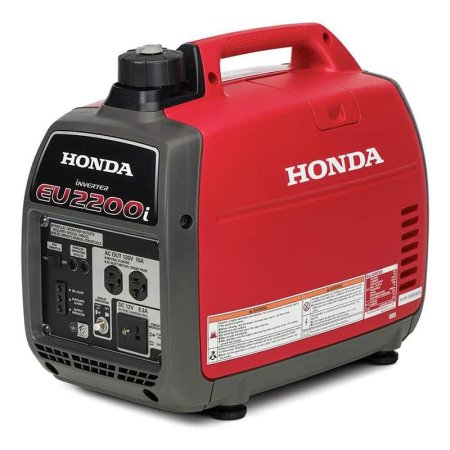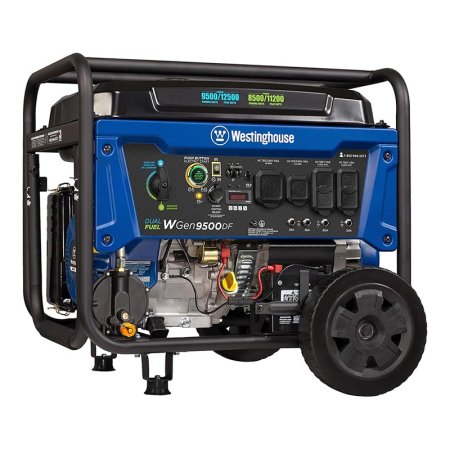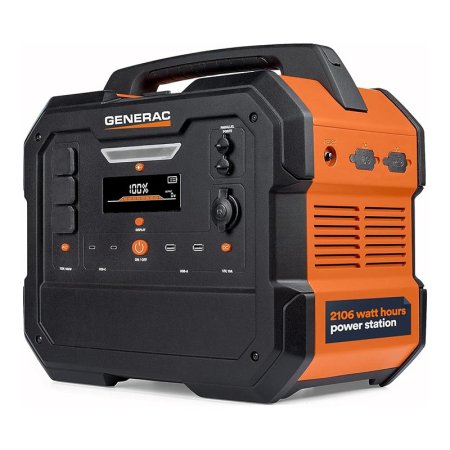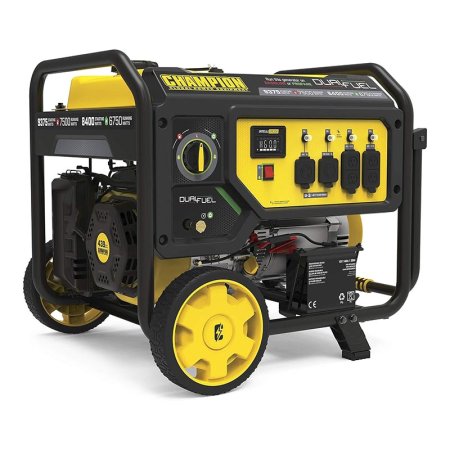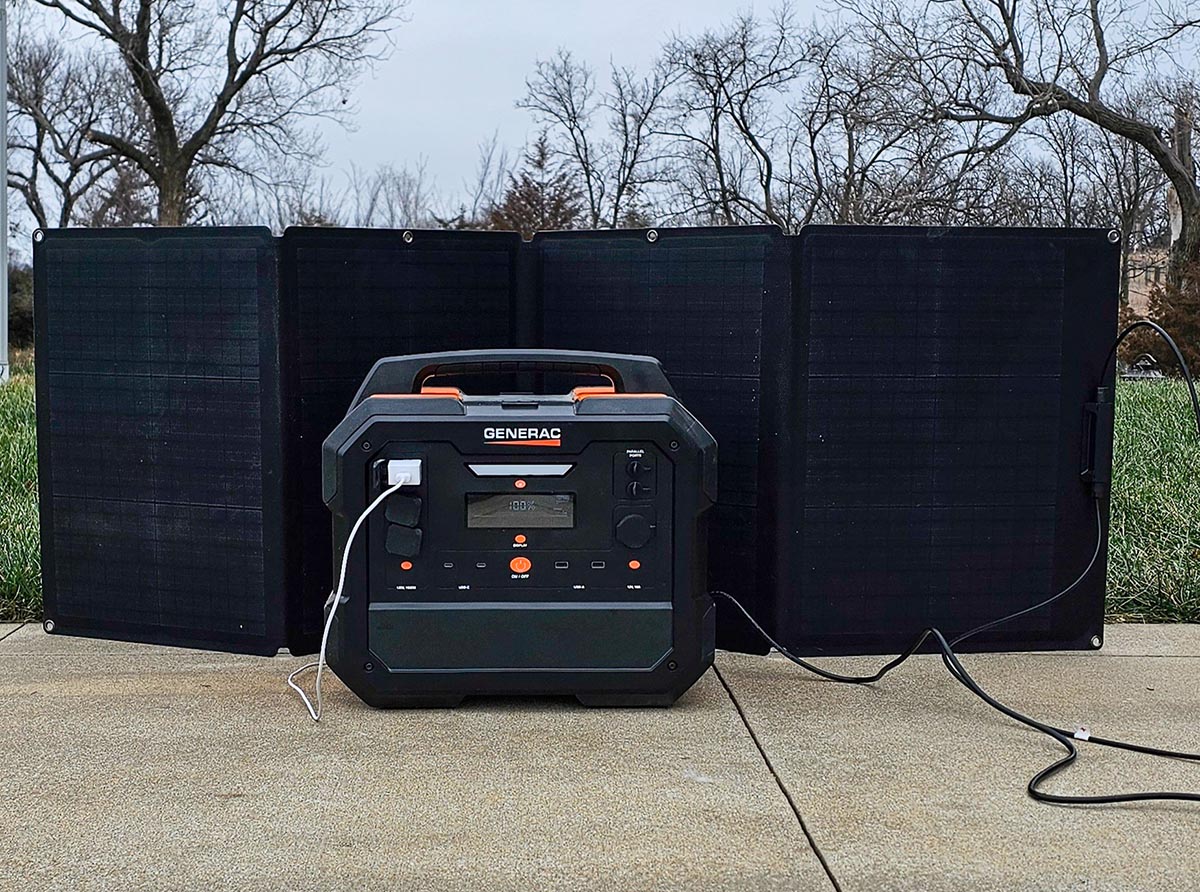
We may earn revenue from the products available on this page and participate in affiliate programs. Learn More ›
During a power outage, a home generator can keep the lights on, the HVAC running, and the appliances powered, but there are a lot of options out there, from whole-house to quiet inverter models. Because we’re big on helping our readers navigate the array of products that make life easier, our team tackled the task of testing home generators.
These independent power sources range in output for a variety of needs. After researching more than 40 top models, we selected the highest-scoring models in a range of categories for hands-on testing. Our favorite was the Dual-Fuel Generator from Champion thanks to its versatile operation and multiple outlets.
Whether you’re looking for a generator to run an entire home or to power only a few essentials, you can find a top-notch one in this lineup. Keep reading to find out how each one performed and to learn more about what to consider when shopping for the best home generator for your needs.
- BEST OVERALL: Champion 8500-Watt Dual-Fuel Generator With CO Shield
- BEST BANG FOR THE BUCK: Pulsar 2200-Watt Dual-Fuel Quiet Inverter Generator
- BEST INVERTER: Westinghouse iGen4500 Inverter Generator
- BEST WHOLE-HOUSE: Briggs & Stratton PowerProtect DX 26kW Home Generator
- BEST QUIET: Honda 2200-Watt Inverter Generator With CO-Minder
- BEST DUAL-FUEL: Westinghouse WGen9500DF Dual-Fuel Generator
- BEST POWER STATION: Generac GB2000 Portable Power Station
- ALSO CONSIDER: Champion 7500-Watt Dual-Fuel Generator

Product Comparison
| Wattage | Fuel | Outlets/Ports | Weight | |
| Champion 8500-Watt Dual-Fuel Generator With CO Shield | Gasoline: 10,625 peak watts and 8,500 running watts; propane 9,565 peak watts and 7,650 running watts | Gasoline or propane | One 120 volt (V)-30 amp (A) locking outlet; one 120/240V-30A locking outlet; four 120V-20A ground-fault circuit interrupter (GFCI) outlets | 209 pounds |
| Pulsar 2200-Watt Dual-Fuel Quiet Inverter Generator | Gasoline: 2,200 peak watts and 1,800 running watts; propane: 2,000 peak watts and 1,600 running watts | Gasoline or propane | Two 120V-15A AC outlets; one USB-A port | 46.5 pounds |
| Westinghouse iGen4500 Inverter Generator | 4,500 peak watts and 3,700 running watts | Gasoline | One 120V-30A outlet; two 120V-20A outlets; 2 USB-A ports | 104.7 pounds |
| Briggs & Stratton PowerProtect DX 26kW Home Generator | 30,000 peak watts and 26,000 running watts | Propane or natural gas | Not applicable | 540 pounds |
| Honda 2200-Watt Inverter Generator With CO-Minder | 2,200 peak watts and 1,800 running watts | Gasoline | Two 125V-20A outlets | 47.4 pounds |
| Westinghouse WGen9500DF Dual-Fuel Generator | Gasoline: 12,500 peak watts and 9,500 running watts; propane: 11,200 peak watts and 8,500 running watts | Gasoline or propane | Four 120V-20A GFCI outlets, one 120V/240V-30A outlet, and one 120/240V-50A outlet | 211 pounds |
| Generac GB2000 Portable Power Station | 3,200 peak watts and 1,600 running watts | AC, DC, or solar | Three 120V-13.3A outlets; one 12V DC port; 2 USB-A ports; 2 USB-C ports | 43 pounds |
| Champion 7500-Watt Dual-Fuel Generator | Gasoline: 9,375 peak watts and 7,500 running watts; propane: 8,400 peak watts and 6,750 watts running | Gasoline or propane | One 120/240V-30A locking outlet; one 120V-30A locking outlet; four 120V-20A GFCI outlets | 205 pounds |
Our Top Picks
When shopping for a generator, it’s easy to become overwhelmed by the available options on the market. While the following models vary in fuel type, electrical load, and intended use, each one earned a spot on this lineup by excelling in real-world tests.
Best Overall
Champion 8500-Watt Dual-Fuel Generator With CO Shield
What We Like
- Runs on both gasoline and propane
- Suits a range of power needs with 6 outlets
- Built-in carbon monoxide (CO) shutoff
What We Don’t Like
- Relatively heavy at 209 pounds
Product Specs
- Wattage: Gasoline: 10,625 peak watts and 8,500 running watts; propane 9,565 peak watts and 7,650 running watts
- Fuel: Gasoline or propane
- Outlets/ports: One 120 volt (V)-30 amp (A) locking outlet; one 120/240V-30A locking outlet; four 120V-20A ground-fault circuit interrupter (GFCI) outlets
- Weight: 209 pounds
Our Ratings: Ease of Use 5/5; Noise 4/5; Portability 5/5; Power 5/5; Value 5/5
Read our full review: Champion 8500-Watt Dual-Fuel Generator With CO Shield
This Champion 8,500-watt generator comes from a well-known manufacturer of quality generators, and it excelled in our hands-on tests. This dual-fuel generator runs on gasoline or propane, so if you stock up on both, you’ll be ready for any power emergency.
We tested several power tools and appliances with the Champion. We also connected it to a travel trailer’s 30A cord, and it generated enough power to run all our appliances without flipping any breakers, even at maximum load. The Champion features six outlets, a digital display for monitoring runtime and power output, and a built-in detector that shuts down the generator if it registers a hazardous carbon monoxide gas level.
However, this is a heavy unit. It weighs 209 pounds without fuel, making it a challenge to lift in and out of the back of a pickup truck bed. But for a powerful home generator to run several tools or appliances simultaneously, this Champion model is tough to beat.
Get the Champion 8,500-watt home generator at The Home Depot.
Best Bang for the Buck
Pulsar 2200-Watt Dual-Fuel Quiet Inverter Generator
What We Like
- Light enough to move around without strain
- Easy to set up and get the engine running
- Ability to run on either propane or gasoline
What We Don’t Like
- Access panel to change the oil was difficult to remove
- Changing the oil required tipping the generator on its side
Product Specs
- Wattage: Gasoline: 2,200 peak watts and 1,800 running watts; propane: 2,000 peak watts and 1,600 running watts
- Fuel: Gasoline or propane
- Outlets/ports: Two 120V-15A AC outlets; one USB-A port
- Weight: 46.5 pounds
Our Ratings: Ease of Use 4/5; Power 4.5/5; Portability 5/5; Noise 4/5; Value 4.5/5
A no-frills dual-fuel generator that’s small enough to tuck away in the corner of a garage or in a truck bed, the Pulsar 2200-watt generator delivered an easy experience powering our test equipment. The 1.18-gallon generator can run for up to 8 hours on half load on a single tank of gas.
Setting up the generator for the first time was fairly straightforward, though filling the oil for the first time proved to be a challenge. The side panel that we needed to unscrew and pop off to access the oil fill port and dipstick was difficult to remove. We also had to lay the generator on its side to fill it with oil, which required a bit of balancing as it’s not completely flat. Balancing while pouring oil was a bit tricky, to say the least. Starting it was a piece of cake. Turning on the Pulsar requires pulling a recoil start, but the engine kicked on after just a couple of pulls—even in the cold.
We used several appliances, including a couple of heat guns and hair dryers at the same time to test the generator at different loads. As promised, the generator handled a combined 1,800 watts without much issue and shut power off when we overloaded it with 2,300 watts.
The Pulsar’s noise level seemed louder than expected, but it was still in a reasonable range for its output. It’s a great option for budget-priced backup power for light-duty power needs such as small DIY projects and powering a couple of household appliances during an outage.
Get the Pulsar home generator at Amazon or Walmart.
Best Inverter
Westinghouse iGen4500 Inverter Generator
What We Like
- Remote control offers starting and stopping from a distance
- Eco mode saves energy when power draw is minimal
- Extendable handle and wheels make it easy for 1 person to move
What We Don’t Like
- Only runs on gasoline with no option for propane
Product Specs
- Wattage: 4,500 peak watts and 3,700 running watts
- Fuel: Gasoline
- Outlets/ports: One 120V-30A outlet; two 120V-20A outlets; 2 USB-A ports
- Weight: 104.7 pounds
Our Ratings: Ease of Use 5/5; Noise 4/5; Portability 4/5; Power 4.5/5; Value 4.5/5
Read our full review: Westinghouse iGen4500 Inverter Generator
It’s hard to beat Westinghouse’s 4,500-watt inverter generator for power output, versatility, and portability. It’s not the highest-wattage model we tested, but it excelled at running several power tools, including grinders and saws, as well as the essentials in our travel trailer. Setting it up was a snap—all we had to do was add oil and fill the gas tank. Best of all, it’s quiet and efficient.
The iGen4500 has a 3.4-gallon gasoline tank that can run up to 18 hours. Since it’s an inverter, it only burns enough to cover the appliances or tools it’s powering. This makes it more eco-friendly than noninverter models that burn fuel at a set rate no matter how much power is being drawn. This backup generator offers a variety of power ports, including a 30A port, two 20A ports, and two USB ports. However, it weighs almost 105 pounds without fuel, so lifting it up and down can be challenging for one person.
While this would be a great emergency generator, we also think it’s a top-notch pick for RVs, camping, and remote powering due to its quiet and efficient operation.
Get the Westinghouse home generator at Amazon, Tractor Supply Co., or Walmart.
Best Whole-House
Briggs & Stratton PowerProtect DX 26kW Home Generator
What We Like
- Turns on automatically within seconds of a power outage
- Supplies ample power to run all appliances, including HVAC
- Users can configure it to run weekly self-tests
What We Don’t Like
- Can’t be installed inside a garage, shed, or other enclosure
- Local codes may require licensed pros to hook up
Product Specs
- Wattage: 30,000 peak watts and 26,000 running watts
- Fuel: Propane or natural gas
- Outlets/ports: Not applicable
- Weight: 540 pounds
Our Ratings: Ease of Use 4/5; Noise 4/5; Portability N/A; Power 5/5; Value 4.5/5
The only standby generator we tested, the Briggs & Stratton PowerProtect is in a class by itself. It requires professional installation, often required by local code, because it connects to electrical power at the meter and to a home’s gas line. Prior to installation, this unit required site analysis and preparation (trenching in electrical lines and pouring concrete for a pad), and we also had an assessment to ensure it could run every appliance at the test home.
Once installed, we tested the generator by shutting off the electricity at the meter, and it started automatically in about 15 seconds. Surprisingly, the Briggs & Stratton only generated about 72 decibels of noise during operation. We turned on an HVAC unit, electric range, and all the lights in the house. We even plugged in some power tools as well, and the generator provided enough power for it all.
Although they can be pricey depending on capacity and local installation fees, standby generators are the best choice for ensuring reliable and comprehensive backup power.
Get the Briggs & Stratton home generator at Lowe’s.
Best Quiet
Honda 2200-Watt Inverter Generator with CO-Minder
What We Like
- Whisper-quiet operation
- Provides cleaner electricity with lower noise
- Lightweight construction and compact build
- Reliable and easy-to-start engine
- CO-Minder advanced CO detection
What We Don’t Like
- Not equipped with USB ports
- Premium price point
Product Specs
- Wattage: 2,200 peak watts and 1,800 running watts
- Fuel: Gasoline
- Outlets/ports: Two 125V-20A outlets
- Weight: 47.4 pounds
Our Ratings: Ease of Use 5/5; Noise 4/5; Portability 4/5; Power 5/5; Value 4/5
The Honda EU2200i inverter generator offers reliability, simple operation, and low noise. Honda estimates that the EU2200i runs at 48 to 57 weighted decibels, and we found that its sound easily gets lost in the background. It comes equipped with a Honda GXR120 commercial series engine that delivers 120 volts and up to 1,800 running watts and 2,200 starting watts. A 125V-20A duplex outlet allows users to plug in two electrical cords without worrying about overloading the generator. T
his machine is compatible with the Honda My Generator mobile app for remote monitoring and is parallel-ready for use with a second Honda EU2200i (connection kit sold separately). It also features a built-in carbon monoxide sensor and safety shutoff. In two separate tests, we used the Honda generator to power a full-size refrigerator for 4 hours and then a portable table saw and miter saw for an 8-hour workday. We even added a USB hub to charge a phone and laptop.
In each test, the devices worked perfectly, the electrical current remained strong and steady, and the breaker didn’t trip. The generator’s molded plastic handle is well placed, and when combined with the machine’s proportions, the unit is fairly easy to carry, even though it weighs nearly 50 pounds. We would have appreciated a built-in USB port in addition to the wall-style outlet, though. As it was, we had to unplug a tool that draws 10A just to charge a device using less than 3A.
Still, a clean electrical current and quiet operation in a lightweight, easy-to-stow package make the Honda an excellent choice for a home backup generator.
Get the Honda home generator at Amazon, Lowe’s, The Home Depot, or Northern Tool + Equipment.
Best Dual-Fuel
Westinghouse WGen9500DF Dual-Fuel Generator
What We Like
- Runs on either gasoline or propane
- Comes with 3 ways to start
- Features digital data display for real-time information
What We Don’t Like
- On the heavy side at 211 pounds
Product Specs
- Wattage: Gasoline: 12,500 peak watts and 9,500 running watts; propane: 11,200 peak watts and 8,500 running watts
- Fuel: Gasoline or propane
- Outlets/Ports: Four 120V-20A GFCI outlets, one 120V/240V-30A outlet, and one 120/240V-50A outlet
- Weight: 211 pounds
Our Ratings: Ease of Use 4.5/5; Power 5/5; Portability 4/5; Noise 4/5; Value 4.5/5
Westinghouse WGen9500DF is an all-around top pick when the power goes out. It has a 6.6-gallon gasoline tank that will keep it running for 12 hours at 25 percent load and up to 8 hours at 50 percent load. (Actual tank runtime may vary depending on gasoline quality and electrical load.) With a 20-pound propane tank, the generator will run up to 7 hours at 50 percent load.
This is a heavy model, weighing 211 pounds, but it mainly came assembled—all we had to do was attach the wheels and the handle. We tested it first with gasoline, followed by propane, and the results were excellent with both fuels. We ran several power tools simultaneously and powered an oven/range and a clothes dryer (at separate times). A nice perk was the remote fob, which allowed us to start the generator from 90 feet away.
The WGen9500DF is a good pick for those who want an emergency generator to power more than just a couple of cell phones.
Get the Westinghouse home generator at Amazon.
Best Power Station
Generac GB2000 Portable Power Station
What We Like
- Charges to full capacity in 3 to 4 hours
- Enough power for tools, appliances, and digital devices
- Designed for emergency, off-grid, or recreational use
What We Don’t Like
- Solar panels are not included
Product Specs
- Wattage: 3,200 peak watts and 1,600 running watts
- Power source: AC, DC, or solar
- Outlets/ports: Three 120V-13.3A outlets; one 12V DC port; 2 USB-A ports; 2 USB-C ports
- Weight: 43 pounds
Our Ratings: Ease of Use 5/5; Noise 5/5; Portability 3.5/5; Power 4.5/5; Value 5/5
A distinct downside with fuel-powered generators is the inability to run them indoors due to hazardous fumes. Power stations, however, can be used indoors to power several appliances and electronic items, depending on their capacity. The Generac GB2000 is a beefy power backup that provides up to 1,600 running watts of electricity and comes with three standard outlets, four USB ports, and a 12V DC car port. Charging the GB2000 took about 3.5 hours when we plugged it directly into a standard AC outlet.
We also charged it with solar panels, but the day was slightly overcast, which kept it from charging quickly—it took about 5 hours to charge from 28 to 100 percent. A sunnier day or stronger solar panels would likely have charged it more quickly. When fully charged, we used it to run our fridge, a miter saw, lamps, a laptop, and cell phone—not all simultaneously. We made about 20 cuts with the miter saw and noticed no lag in the saw’s power. It took a couple of hours to fully charge the cell phone by placing it on the wireless charging panel at the top of the GB2000.
We left the fridge and laptop plugged in for several hours without depleting the battery—we still had 20 percent when we unplugged them. The Generac is well suited as an emergency backup for essential appliances or a remote power source for tailgating and camping, but at 43 pounds, it’s a bit heavy if you plan to carry it very far on trails.
Get the Generac home generator at Amazon, Lowe’s, Tractor Supply Co., The Home Depot, Walmart, or Generac.
Also Consider
Champion 7500-Watt Dual-Fuel Generator
What We Like
- Fuel efficient
- Easy-to-use electric start is user-friendly
- Digital screen tracks voltage, hertz, and runtime
- Features a built-in surge protector and automatic low-oil shutoff
What We Don’t Like
- Higher fuel consumption than more efficient models
- Heavy at 205 pounds
Project Specs
- Wattage: Gasoline: 9,375 peak watts and 7,500 running watts; propane: 8,400 peak watts and 6,750 watts running
- Fuel: Gasoline or propane
- Outlets/ports: One 120/240V-30A locking outlet; one 120V-30A locking outlet; four 120V-20A GFCI outlets
- Weight: 205 pounds
Our Ratings: Ease of Use 4.5/5; Noise 4/5; Portability 4/5; Power 5/5; Value 5/5
This Champion 7,500-watt dual-fuel generator delivers enough electricity to power up an off-grid jobsite or keep critical home circuits running through a utility outage. It includes numerous convenience features, like a push-button electric starter, covered outlets, and a fold-out transport handle. In our tests, the push-button starter worked perfectly, no matter the weather.
We appreciated its two locking 30A outlets (one 120V and one 120/240V) for powering a home, workshop, RV, or heavy-duty tools like portable welders. It also has four household-style 120V-20A outlets for lower-wattage applications. On a 7.7-gallon tank of gas, this generator supports a 50 percent load for up to 10 hours or up to 5.5 hours with a 20-pound propane cylinder. Using propane, we ran a portable table saw, miter saw, router, and air compressor for 4 hours and had just under half a tank of propane left over.
On the downside, its heavy weight made it tough to navigate across a yard and lift in and out of a truck. It also does not include an idle controller, which leads to more fuel consumption than eco-throttle-equipped generators. Still, it offered plenty of power and access points for the price.
Get the Champion 7500-watt home generator at Blain’s Farm & Fleet.
Jump to Our Top Picks
How We Tested the Best Home Generators
Before testing, we carefully researched more than 40 portable and standby generators and over a dozen high-capacity power stations. We looked at consumer satisfaction, ease of use, price, and versatility. We also considered brand reputation—manufacturers like Champion, Honda, Westinghouse, and Briggs & Stratton are highly respected in the generator industry.
Our goal was to pinpoint models that would suit diverse user needs. This list includes powerful, gas-fueled, and dual-fueled generators in addition to quieter inverters and even solar power stations.
Team members assembled and fueled the generators using the appropriate fuel types. Then we plugged in power tools, home appliances, and electronic devices to see if the generators would produce the advertised wattage. We used an online wattage calculator to help us estimate the correct wattage for testing. In addition, we took note of the noise the generators produced when operating (some models are quieter than others), and we took portability into account.
For each generator, we awarded points based on quality and performance. At the end of testing, we averaged the points to determine which models were best suited to specific applications and users.
| Ease of Use | Noise | Portability | Power | Value | |
| Champion 8500-Watt Dual-Fuel Generator With CO Shield | 5 | 4 | 5 | 5 | 5 |
| Pulsar 2200-Watt Dual-Fuel Quiet Inverter Generator | 4 | 4.5 | 5 | 4 | 4.5 |
| Westinghouse iGen4500 Inverter Generator | 5 | 4 | 4 | 4.5 | 4.5 |
| Briggs & Stratton PowerProtect DX 26kW Home Generator | 4 | 4 | N/A | 5 | 4.5 |
| Honda 2200-Watt Inverter Generator With CO-Minder | 5 | 4 | 4 | 5 | 4 |
| Westinghouse WGen9500DF Dual-Fuel Generator | 4.5 | 5 | 4 | 4 | 4.5 |
| Generac GB2000 Portable Power Station | 5 | 5 | 3.5 | 4.5 | 5 |
| Champion 7500-Watt Dual-Fuel Generator | 4.5 | 4 | 4 | 5 | 5 |
Testing Stats
Products tested: 8
Hours spent testing: 55
Tests performed: 5
Average price: $1651
What to Consider When Choosing a Home Generator
Several factors can affect each type of generator’s overall functionality when the power goes out. Keep the following considerations in mind when searching for the best home generator to keep you powered up when severe weather or a natural disaster causes an outage.
Types of Home Generators
Finding the best generator for your power needs involves weighing the four types available. Each type has its own set of pros and cons, and one is likely to suit your home’s specific needs better than the others.
Home Standby Generators
Home standby generators, also called whole-house generators, are large, permanently installed generators that connect to a home’s electrical panel for backup power during an electrical outage. They are equipped with an automatic transfer switch (explained in later sections) that automatically switches on the generator’s power supply when it detects a loss of utility power. Home standby generators are most commonly powered by natural gas or propane, but some diesel models are available.
Home standby generators have the largest power ratings and are usually, though not always, powerful enough to satisfy the electrical demands of an entire home. They can power utilities such as water heaters and central air conditioners. The downside is that they’re the most expensive to purchase and install and require installation by certified professionals. An electrician is needed to connect it to the electrical panel, and a plumber may be required to connect the propane or natural gas line to the generator.
Portable Generators
As the name suggests, portable generators are small and can be moved to different locations. Compared to standby options, these are cheap home generators. They can have a wide range of power output ratings. Some may only power a limited number of electrical items and appliances, while large-capacity portable generators may have a 30A outlet for connecting a transfer switch.
Many options are gas-powered generators, but some are powered by diesel or propane. Multifuel generators (dual- and tri-fuel) are powered by multiple fuel sources, including gasoline, diesel, propane, and/or natural gas. Be advised that fuel-powered generators should never be used indoors since the engine can emit a toxic level of CO, leading to sickness or death.
Inverter Generators
Inverter generators are technically a type of portable generator, but they offer a different set of pros and cons. As opposed to conventional generator engines that constantly operate at the same output rate, inverter generators adapt to power demand.
This makes them more fuel efficient, allowing them to have smaller fuel tanks and more portability than other generators. This efficiency reduces their CO emissions. It also makes them quiet generators, usually only producing around a 60-decibel noise level—the same volume level as a typical conversation.
All of these advantages make them a popular choice among campers and RVers who value silent operation and portability. The disadvantages? Inverter generators are typically more expensive than regular portable generators and generally produce less power.
Portable Power Stations
Portable power stations are essentially battery banks that store electrical power. Instead of using gasoline, diesel, propane, or natural gas, power stations are charged in a standard electrical outlet or via solar panels. Solar-powered power stations are often called solar generators and offer a practically unlimited and renewable power source—just as long as the sun is shining.
These power stations are usually designed to be compact and lightweight for incredible portability. They are also virtually silent when in operation. In addition, they can be safely used indoors since they don’t produce any harmful emissions.
The primary disadvantages are that they’re usually more expensive than conventional portable generators and have significantly lower power output. That being said, they can be used to power a handful of essential appliances during an outage.
Fuel or Energy Type
- Gasoline: A widely available fuel source, gasoline is a common fuel source for portable generators. The primary disadvantages are that gasoline is more expensive and less efficient than other fuel sources, and gasoline engines typically emit the highest levels of CO. Also, storing gasoline in a gas can for long periods of time requires a fuel stabilizer and can present a significant fire hazard if stored incorrectly.
- Diesel: Although generators fueled by diesel aren’t as common as those fueled by gasoline, diesel is more efficient and can be stored for longer periods without a stabilizer. Diesel storage also doesn’t pose as significant a fire hazard as gasoline.
- Propane: Propane is a common fuel source for standby generators and may either be tied into a home’s primary propane gas tank or have a designated tank strictly for the generator. It’s not commonly a primary fuel source for portable generators, but some tri-fuel and dual-fuel generators accommodate propane as a backup fuel source. The main disadvantages are that propane isn’t as energy efficient as other fuel sources, and a generator fueled by propane will usually have a lower runtime and produce less power. Propane also presents a fire hazard if stored incorrectly.
- Natural gas: As a fuel source, natural gas is used exclusively with standby generators. For use with a generator, it is tied into a home’s natural gas line to offer a practically limitless source of fuel. The disadvantages are that natural gas is less energy efficient than propane and considerably less energy efficient than diesel and gasoline.
- Solar energy: As a source of power for portable battery banks, solar energy is silent and clean. It’s also free. The disadvantages are that the power capacity is determined by the number and size of the panels and the size of the battery it charges. A solar panel’s ability to charge a battery is also dictated by the amount of available sun, so it isn’t as reliable a fuel source as other options.
Size
A generator’s size equates to the amount of power in watts it can generate, ranging from 800 to greater than 50,000-watt power capacity. Generators are sized in both “peak watts” (also called “starting watts”) and “running watts,” but the running watts rating reveals how many continuous watts the generator can supply to keep the electricity running to the connected items. Peak watts are the number of watts the generator can produce for a few seconds to satisfy the extra demand from starting motor-driven items like power tools.
The running watts rating dictates the number of electrical appliances you can run simultaneously and for how long. Because a generator’s starting watts can be 1,000 to 2,000 watts greater than its running watts, it’s important to understand the difference when determining your home’s power requirements.
Power Requirements
To determine the generator size you need, calculate the total number of watts your most essential electrical items consume. All electrical appliances are required to have a label that displays their wattage rating; you simply need to add together the wattage figure listed on each item you want to power during an electrical outage.
Generally speaking, a refrigerator consumes between 700 and 1,200 watts; a window air conditioner consumes around 1,000 watts; a portable space heater consumes about 1,500 watts; and lights can be anywhere between 60 and 600 watts. Most households typically require around 5,000 watts to power the most essential components.
Transfer Switch
A transfer switch connects a generator to a home’s main electrical panel and allows you to switch, or “transfer,” between grid power and generator power. There are both manual and automatic transfer switches. Manual transfer switches require you to physically switch over the power at your electrical panel when the power goes out, while an automatic transfer switch automatically switches over power from the grid to generator power when it detects a loss of power.
Convenience
Generators can be equipped with various features that make their operation as convenient as possible. These include:
- Electric start: Instead of using a pull cord to manually start a generator, many modern generators offer an effortless electric start. This mechanism can be in the form of a push button, a switch, and even a remote control.
- Multiple outlets: Not only are multiple outlets convenient, but they also help distribute the generator’s electrical load when powering multiple appliances. Having a generator with at least four household electrical outlets is recommended for efficiently spreading the electrical load. Generators may also have household 30A, RV 30A, and 50A outlets as well as USB ports.
- Low-oil shutoff: A generator with a low-oil shutoff will automatically turn off when the oil falls below a certain level. This feature can save a generator from irreparable engine damage caused by low oil levels.
- Fuel gauge: A fuel gauge allows you to closely monitor the fuel level in the generator. This feature is typically only necessary for gasoline- and diesel-powered generators with internal fuel tanks. However, solar-powered battery banks usually have battery life indicators, and propane tanks often have integrated fuel gauges.
Safety
Along with the various features that contribute to convenience, there are also a few important safety features that many generators incorporate into their design, particularly with regard to CO detection. These include:
- Automatic CO shutoff: To reduce the risk of poisoning, many portable generators are equipped with an internal CO sensor that will automatically shut off the generator when CO levels reach a certain level. This feature can be labeled as “CO Sense,” “CO Shield,” “CO Protect,” and similar designations.
- Low-CO engine: Along with an automatic CO shutoff, some generator engines are specifically designed to emit considerably less CO. Despite being safer than conventional engines, low-CO engines still shouldn’t be operated indoors.
Tips for Using a Home Generator
Operating a generator isn’t complicated, but there are a few tips you’ll want to keep in mind to ensure effective and safe operation and avoid any harm to yourself or your generator when the power goes out.
First of all, it’s important to use extension cords that are sufficiently powerful. As a general rule, use at least 12-gauge outdoor-rated electrical cords for larger appliances (like refrigerators) and at least 14-gauge cords for everything else. Cord length is also a concern since the voltage drop from cords that are too long can damage or destroy the appliances they’re supplying. Although you’ll want to keep a portable generator outside and away from your home, remember not to exceed a 100-foot extension cord length.
When running a home generator, it’s best to keep it on a level surface. If a generator is placed on a slope or hill, the internal lubrication system could malfunction and lead to premature engine wear and damage. Finally, ensure the generator has cooled down before you refill it since spilling gasoline on a hot engine can cause a fire.
Keep the following tips in mind:
- Prevent theft by securing your generator with a lock and chain if you store it outside.
- Don’t run your generator with stale fuel to avoid start-up issues.
- Keep extra oil and filters on hand to ensure you can maintain the recommended maintenance schedule through extended power outages.
FAQs
Since generators can be both lifesaving and expensive, it’s natural to have some questions before you’re confident in your decision. To this end, consider the answers to these frequently asked questions. Together with the above shopping considerations, these answers provide you with just about everything you need to know about emergency power generators.
Q. Do I need a permit for a home generator?
Most municipalities and towns require that you have a permit before a standby generator is installed. However, not all locations have this requirement. Check with your local zoning authority to find out if a permit is required in your community.
Q. What size generator do I need for my house?
To determine the necessary power rating for your generator, add up the wattage of all the appliances you want to run during an electrical outage. As a general rule, a generator should have at least a 5,000-watt capacity to power a home’s essential appliances. But, your home could require substantially more power than that.
Q. Do home generators need oil?
Yes, fuel-powered home generators require oil to operate properly without wearing out the moving parts.
Q. Where should a whole-house generator be located?
Most manufacturers recommend that the whole-house generator be installed at least 5 feet from doors, windows, vents, and any flammable material. There may also be local regulations about the placement of a whole-house generator, so make sure to check local guidelines to ensure that your whole-house generator meets local building codes and installation guidelines.
Q. Can you plug a generator into a house outlet?
No. A generator should not be plugged into a house outlet because it is both dangerous and illegal in many locations. This is called backfeeding and it can severely damage the home’s electrical system or even cause a fire. Additionally, any technicians who are working on electrical lines on the same power grid are at increased risk of electrocution.
Q. How do you hook up a generator to your house?
You can connect a generator to individual appliances using a series of extension cords, or if you want direct power for entire circuits in the home, have a standby generator professionally installed.
Q. How long does it take to install a whole-house generator?
On average, it will take an experienced technician about 1 to 2 full days to complete the installation of your whole-house generator. It could take 1 to 2 weeks to prep for the installation, such as pouring a concrete pad and running the wires connecting the generator to the electrical panel.
Q. How long do whole-house generators last?
The exact lifespan depends on the specific product, but in general, the overall lifespan of a whole-house generator is about 1,500 to 3,000 hours.
Meet the Testers
The Bob Vila test team is made up of contractors, remodelers, home design enthusiasts, and freelancers from across the nation. Each member is dedicated to delivering high-quality product information to our readers so they can shop with confidence, knowing the products they purchase have been fully tested and vetted.
Austin Fracchia is a writer and manager at BobVila.com. As a DIY hobbyist, he tests products with a focus on user-friendliness and reliability so readers can find the right products for their home projects.
Zach Lazzari is a freelance writer splitting time between the great outdoors, travel, and DIY projects ranging from camper builds to home renovations and maintenance.
Glenda Taylor is a contractor, product tester, and writer. She focuses primarily on construction, woodworking, and DIY tools and techniques.
Mark Wolfe is a writer and product tester, focused on mechanical durability and user convenience. As a green industry veteran and an avid DIYer, he has gained valuable insight on choosing dependable power equipment and avoiding poor-quality machinery.
Additional research was provided by Timothy Dale and James Fitzgerald.




